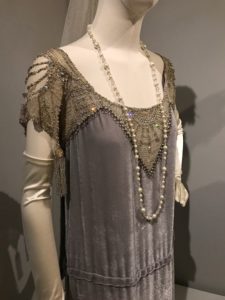It was hard to contain my excitement when my husband and I recently visited Nashville for the “Dressing Downton” traveling exhibit. It’s been almost two years since the farewell sixth season of Downton Abbey–where we fell in love with the British aristocratic Crawley family and their devoted staff. I, for one, still miss them.
The actors breathed life into their characters. And the exquisitely detailed costumes played a major role in authenticating the fashion and lifestyle of the times.

Oh, if these costumes could talk. What would they say?

If this muted purple gown, worn in the first season by Dowager Countess Violet Crawley, could speak it might say: “I am still in half-mourning for my family who lost their lives on the Titanic.”
(The silhouette of this silk day dress is dictated by the S-bend corset that accentuates the bosom, squeezes in the waist, and pushes out at the back, as did the bustle before it.)

Costumes worn at the hospital’s Charity Concert.

These costumes signify the sense of tradition and duty strongly held by Cora and Robert Crawley (Earl of Grantham).
They say: “We represent the pinnacle of local society and take our responsibility towards those who live and work among us very seriously.


These costumes declare: “We are in a Great War. Our colors will be subdued. No more full skirts. Material is at a premium. Mustn’t be wasteful.”
(Matthew Crawley’s uniform was most likely made by his own tailor, but for multitudes of ordinary soldiers, uniforms had to be mass-produced. This more efficient method of ready-made clothing, created at lower cost, had a huge impact on the general public after the war.)
Edith’s costumes might tell a different story: “I’m not an heiress, and I don’t see any prospects for a husband, so I will try to find my own way–perhaps by helping on the estate.”


(During the war, women stepped up to fill the jobs men left behind. Edith drove the family car and even rode on a tractor. She was dubbed, “a land girl,” and wore masculine clothing, which was unheard of before the war.)

After the war, Edith’s apparel would announce: “I’ll get a job in London, and become an independent women in my own right.”
(This exquisite coat is an example of the influence of the Arts and Crafts style, a movement that emerged in England during the late Victorian Period. Note: less frills and cleaner lines.)
Of course there was always a deliniation between those living above the stairs and those living below. And even within the servants, there existed a definite hierarchy.

Mr. Carson, Mrs. Hughes, and Miss O’brien.


Mrs. Hughes was chief female and head of housekeeping. She dressed to emphasize her managerial status. As a mark of respect, housekeepers were alway referred to as “Mrs.” whether they were married or not.
Her uniform would announce: “I am the keeper of the keys to this estate.”

Lady’s maid Anna Smith was responsible for dressing Lady Mary Crawley in the morning and again in the evening. “Upper-class women usually dressed themselves for afternoon tea in what was called a “tea gown,” a looser garment that could be worn without a corset. The Lady’s Maid was also expected to care for clothes and fix hair, which was worn “up” as soon as girls stopped their schooling. The maid also helped select jewelry for her mistress, but not make-up, as none was worn at the time.” –excerpt from Dressing Downton Exhibit)

In Season 3, Cora Crawley’s American mother, Martha Levinson, arrives at Downton.


This luxe silk coat is trimmed with fox fur collar and cuffs and accessorized with a velvet purse and carved bone clasp.
If this flamboyant costume could speak, it would proclaim: “I want to make a sweeping entrance and let everyone know that I’m here in all my grandeur.”
The presentation of eligible young ladies to the King and Queen of England was one of the most formal events on the Royal calendar. An exceptionally strict dress code dictated that ladies wear a white or pale evening dress with a train. They were required to carry a fan or bouquet, and a wear a headdress with three white Prince-of-Wales feathers (three ostrich feathers attached to a gold coronet).



By today’s standards these dress requirements might seem superficial and archaic, but for the the members of the elite British aristocracy, and the people they employed, this was time-honored tradition.
And for the millions of viewers who made Downton Abbey the most-watched PBS mini series of all time, clearly something was keeping us intrigued week after week.
I, for one, wouldn’t mind a Downton reunion. What about YOU?

Those were the days.
You still have an opportunity to view these exquisite costumes. The Dressing Downton exhibit has one more stop in St. Augustine, FL. Go to Dressing Downton Tour Schedule for information.





2 Comments
I so miss Downton Abbey! You’ve helped me relive some of the best moments with this post, Sharon. The costumes were fantastic in this series and I wish I could see the traveling exhibit. Instead, I guess I’ll start rewatching the series. I hope there is a reunion!
Molly,
Maybe we should all petition Julian Fellowes for a reunion!